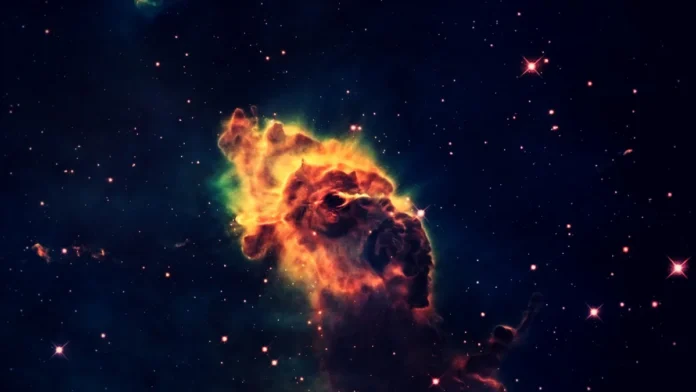In A Groundbreaking Development For Astronomy, Scientists Have Captured A Close-Up Image Of WOH G64, A Dying Star Located An Incredible 1,60,000 Light-Years Away From Our Galaxy, The Milky Way. This Star, A Red Supergiant With A Mass 2,000 Times That Of The Sun, Is In The Final Stages Of Its Life, And The New Image Reveals Crucial Details About Its Activity. The Observation Offers A Rare Glimpse Into The End Of A Star’s Lifecycle, Paving The Way For Future Discoveries About The Evolution Of Massive Stars.
For The First Time Ever, A Team Of Researchers Led By Keiichi Ohnaka From Universidad Andres Bello In Chile Managed To Capture A Close-Up Image Of WOH G64 Using The European Southern Observatory’s Very Large Telescope Interferometer (ESO’s VLTI). This Image Reveals The Star Emanating Gas And Dust—Signs That It Is Approaching Its Ultimate Fate As It Prepares To Explode In A Supernova.
The Historic Observation Of WOH G64
Keiichi Ohnaka, The Lead Astrophysicist Behind The Study, Shared His Excitement About This Remarkable Achievement: “For The First Time, We Have Succeeded In Taking A Zoomed-In Image Of A Dying Star In A Galaxy Outside Our Own Milky Way.” The Latest Observation, Published In Astronomy And Astrophysics, Marks A Major Milestone In Astronomical Research.
The Team’s New Findings Offer A Detailed Look At WOH G64’s Physical Characteristics. The Star Is Surrounded By An ‘Egg-Shaped Cocoon’ Of Dust And Gas, Which Provides A Crucial Clue About The Star’s Imminent Fate. As A Red Supergiant, WOH G64 Is In The Final Stage Of Its Lifecycle, And This Discovery Provides A Glimpse Into The Star’s Transition Into A Supernova—An Explosive Event Marking The End Of Its Life.

What Is WOH G64?
WOH G64 Is A Colossal Red Supergiant Star That Resides In The Large Magellanic Cloud (LMC), A Dwarf Galaxy That Orbits Our Milky Way. The LMC Is One Of The Closest Galaxies To Our Own, Located Around 1,60,000 Light-Years Away From Earth. WOH G64 Was First Discovered In The 1970s By Astronomers Bengt Westerlunds, Olander, And Hedin, With The “WOH” Acronym Representing The First Letters Of Their Names.
With A Size Approximately 2,000 Times Larger Than The Sun, WOH G64 Is One Of The Largest Stars Ever Discovered. The Star’s Enormous Size And Mass Make It A Fascinating Object Of Study, Especially As It Approaches The End Of Its Life Cycle.
The Team’s Long-Term Observations
The Team Led By Ohnaka Has Been Studying WOH G64 For Years, With Earlier Observations In 2005 And 2007 Using The VLTI At The Atacama Desert In Chile. While The Team Had Studied The Star’s Features In The Past, It Was Only Recently That They Were Able To Capture A Clear Image Of It.
To Achieve This Remarkable Image, The Team Had To Wait For The Development Of The GRAVITY Instrument, A Second-Generation Tool That Was Added To The VLTI. With The GRAVITY Upgrade, They Were Able To Capture An Image Of The Star With Unprecedented Clarity. This Image Reveals That WOH G64 Has Dimmed Over The Past Decade, Suggesting Significant Changes In The Star’s Activity.
The Star’s Dimming and Evolution
George Weigelt, A Co-Author Of The Study And Astronomy Professor At The Max Planck Institute For Radio Astronomy, Explained That The Star Has Gone Through Significant Changes Over The Last Ten Years. Red Supergiants Like WOH G64 Shed Their Outer Layers—Composed Mainly Of Gas And Dust—During The Final Stages Of Their Lives. This Process Can Continue For Thousands Of Years, And It Is Likely That The Materials Being Shed Are Contributing To The Star’s Dimming.
WOH G64’s Dramatic Changes In Brightness And The Unique Egg-Shaped Dust Cocoon Around It Could Be Signs That The Star Is Approaching The Final Phase Of Its Life. According To Jacco Van Loon, Director Of Keele Observatory In The UK, “Any Drastic Change May Bring It Closer To An Explosive End.” This Likely Refers To The Star’s Imminent Supernova, A Cataclysmic Event That Will Mark The End Of WOH G64.

The Future of VLTI and Stellar Research
As WOH G64 Continues To Shed Its Outer Layers And Fade, Capturing Close-Up Images Of Such Distant And Faint Stars Will Become More Challenging. However, The Introduction Of The GRAVITY+ Instrument—An Upcoming Upgrade To VLTI—Holds The Promise Of More Detailed Images In The Future.
This New Instrument Will Help Astronomers To Capture Even Sharper Images Of Fainter Stars In Distant Galaxies, Making It Possible To Study The Evolution And Death Of Stars More Closely Than Ever Before. With Continued Technological Advancements, The Field Of Stellar Research Is Poised To Take Major Leaps, Unveiling More Secrets About The Life Cycles Of Massive Stars Like WOH G64.
Why WOH G64 Matters?
The Observation Of WOH G64 Marks A Major Step In Understanding The Evolution Of Massive Stars. It Provides Astronomers With Rare Insights Into The Final Stages Of A Star’s Life And The Processes That Lead To A Supernova. This Knowledge Is Crucial For Understanding The Life Cycle Of Stars, Which Plays A Key Role In The Formation Of New Elements And The Evolution Of Galaxies.
WOH G64’s Dimming And The Surrounding Dust Cocoon Offer Vital Clues About The Star’s Transition Into A Supernova, And The Study Of This Star Will Help Scientists Learn More About The Last Days Of Red Supergiants Across The Universe.

